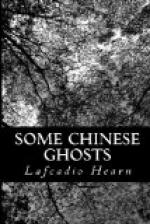LI-SHU.—The second of the six styles of Chinese writing, for an account of which see Williams’s “Middle Kingdom.” ... According to various Taoist legends, the decrees of Heaven are recorded in the “Seal-character,” the oldest of all; and marks upon the bodies of persons killed by lightning have been interpreted as judgments written in it. The following extraordinary tale from the Kan-ing-p’ien affords a good example of the superstition in question:—
Tchang-tchun was Minister of State under the reign of Hoei-tsong, of the Song dynasty. He occupied himself wholly in weaving perfidious plots. He died in exile at Mo-tcheou. Sometime after, while the Emperor was hunting, there fell a heavy rain, which obliged him to seek shelter in a poor man’s hut. The thunder rolled with violence; and the lightning killed a man, a woman, and a little boy. On the backs of the man and woman were found red characters, which could not be deciphered; but on the back of the little boy the following six words could be read, written in Tchouen (antique) characters: TSE-TCH’IN-TCHANG-TCHUN-HEOU-CHIN,—which mean: “Child of the issue of Tchang-tchun, who was a rebellious subject.”—Le Livre des Recompenses et des Peines, traduit par Stanislas Julien, p. 446.
PAGAL.—The ankle-ring commonly worn by Hindoo women; it is also called nupur. It is hollow, and contains loose bits of metal, which tinkle when the foot is moved.
SAN-HIEN.—A three-stringed Chinese guitar. Its belly is usually covered with snake-skin.
SIU-FAN-TI.—Literally, “the Sweeping of the Tombs,”—the day of the general worship of ancestors; the Chinese “All-Souls’.” It falls in the early part of April, the period called tsing-ming.
TA-CHUNG SZ’.—Literally, “Temple of the Bell.” The building at Pekin so named covers probably the largest suspended bell in the world, cast in the reign of Yong-lo, about 1406 A.D., and weighing upwards of 120,000 pounds.
TAO.—The infinite being, or Universal Life, whence all forms proceed: Literally, “the Way,” in the sense of the First Cause. Lao-tseu uses the term in other ways; but that primal and most important philosophical sense which he gave to it is well explained in the celebrated Chapter XXV. of the Tao-te-king.... The difference between the great Chinese thinker’s conception of the First Cause—the Unknowable,—and the theories of other famous metaphysicians, Oriental and Occidental, is set forth with some definiteness in Stanislas Julien’s introduction to the Tao-te-king, pp. x-xv. ("Le Livre de la Voie et de la Vertu.” Paris, 1842.)
THANG.—The Dynasty of Thang, which flourished between 620 and 907 A.D., encouraged literature and art, and gave to China its most brilliant period. The three poets of the Thang dynasty mentioned in the second story flourished between 779 and 852 A.D.




